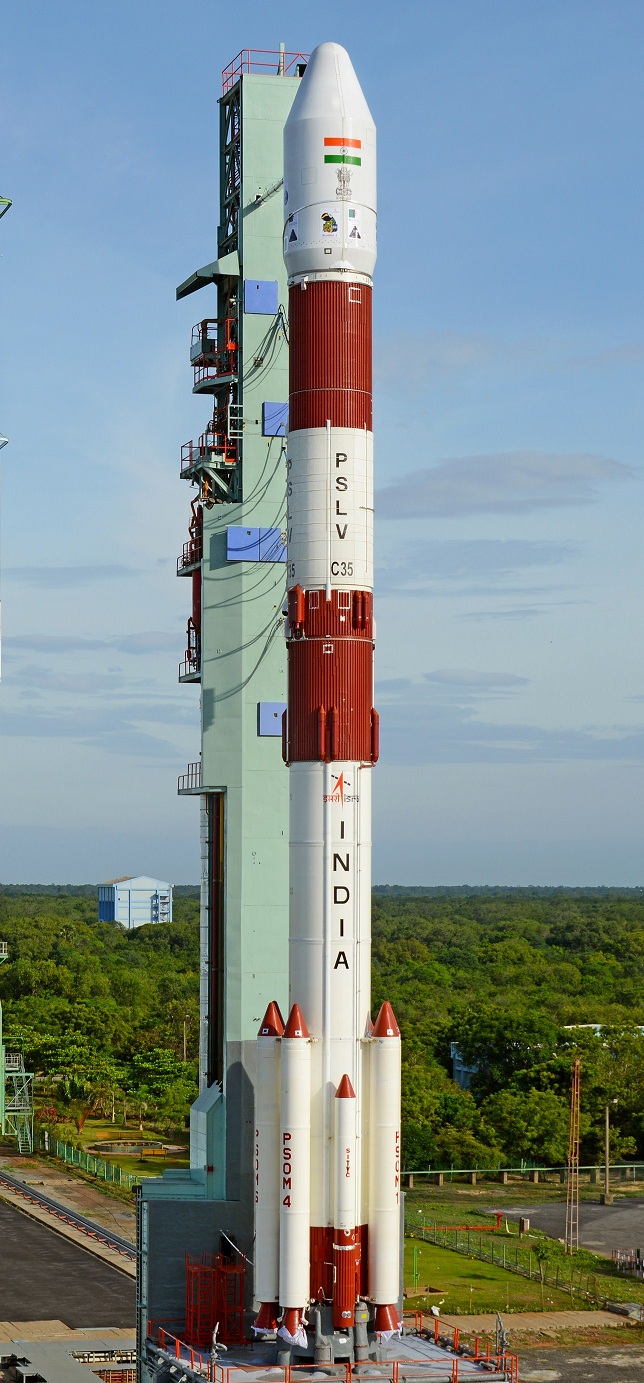Polar Satellite Launch Vehicle (PSLV)

PSLV-C35 (23 September 2016). Photo Credit : ISRO, Department of Space, Government of India. Public domain, via Wikimedia Commons.
The Polar Satellite Launch Vehicle (PSLV) is an expendable medium-lift launch vehicle designed and operated by the Indian Space Research Organisation (ISRO)
Quick Facts About PSLV.
- Type: Medium-lift launch vehicle.
- Origin : India.
- Manufacturer: ISRO.
- In service : (PSLV-CA): 23 April 2007 - Active, (PSLV-XL): 22 October 2008 - Active.
- Mass : PSLV-CA: 230,000 kg (510,000 lb), PSLV-XL: 320,000 kg (710,000 lb).
- Length/Height :44 m (144 ft).
- Diameter : 2.8 m (9 ft 2 in).
- Payload to LEO : 3,800 kg (8,400 lb).
- Payload to SSO: 1,750 kg (3,860 lb).
- Payload to Sub-GTO : 1,425 kg (3,142 lb) .
- Payload to GTO : 1,300 kg (2,900 lb).
- Propellant: Boosters/First stage: HTPB solid. Second stage: N2O4/UDMH. Third stage: HTPB solid. Fourth stage: MMH/MON
- Engines: Boosters: (XL) 6 x S12 Solids with thrust of 4,221 kN (949,000 lbf) (XL). First stage: 1 solid with thrust of 4,846.9 kN (1,089,600 lbf). Second stage : 1 Vikas with thrust of 803.7 kN (180,700 lbf). Third stage : 1 Solid with thrust of 240 kN (54,000 lbf). Fourth stage : 2 x L-2-5 with thrust of 14.66 kN (3,300 lbf).
The PSLV was developed to allow India to launch its Indian Remote Sensing (IRS) satellites into sun-synchronous orbits, a service that was, until the advent of the PSLV in 1993, commercially available only from Russia. PSLV can also launch small size satellites into Geostationary Transfer Orbit (GTO).
Some notable payloads launched by PSLV include India's first lunar probe Chandrayaan-1, India's first interplanetary mission, Mars Orbiter Mission (Mangalyaan) and India's first space observatory, Astrosat.
PSLV has gained credence as a leading provider of rideshare services for small satellites, due its numerous multi-satellite deployment campaigns with auxiliary payloads usually ride sharing along an Indian primary payload. As of February 2021, PSLV has launched 342 foreign satellites from 36 countries. Most notable among these was the launch of PSLV-C37 on 15 February 2017, successfully deploying 104 satellites in sun-synchronous orbit, tripling the previous record held by Russia for the highest number of satellites sent to space on a single launch, until 24 January 2021, when SpaceX launched the Transporter-1 mission on a Falcon 9 rocket carrying 143 satellites into orbit.
Payloads can be integrated in tandem configuration employing a Dual Launch Adapter.Smaller payloads are also placed on equipment deck and customized payload adapters.
Credit/References and for further info please see:
https://en.wikipedia.org/wiki/Polar_Satellite_Launch_Vehicle

PSLV C45 launch from Second Launch Pad of Satish Dhawan Space Centre (1 April 2019). Photo Credit : ISRO, Department of Space, Government of India. Public domain, via Wikimedia Commons.

PSLV-C44 Integrated up to First Stage inside Mobile Service Tower (4 January 2019). Photo Credit : ISRO, Department of Space, Government of India. Public domain, via Wikimedia Commons.

PSLV C50 second stage with Vikas engine (11 December 2020). Photo Credit : ISRO, Department of Space, Government of India. Public domain, via Wikimedia Commons.